KATY Explore









The ultimate open/enclosed wedding venue just west of Houston, Texas! We offer four unique and flexible venues that will transport you to an oasis all your own.


From saying “I do” in our Spanish mission-inspired chapel overlooking the river, to a reception unlike any other in our awe-inspiring Palapa. Your guests will be ushered through the grounds for an unforgettable experience.

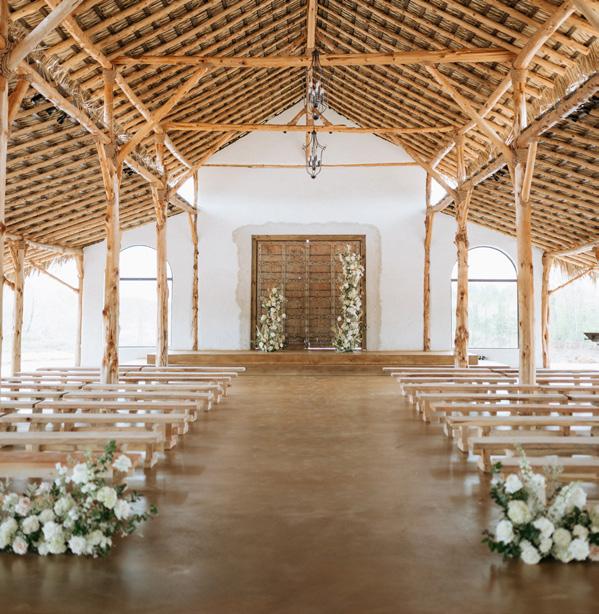

It’s a wonderful time of year! Longer days, fragrant flowers, rain showers, pool parties, and refreshing popsicles – all things that make me smile when I think of these summer months.

Being outside never fails to lift my mood. The American Psychological Association writes time and again about the immediate and lasting benefits of nature on our psyches. Even just an image of a peaceful forest or calm Caribbean beach increases positivity and aids in problem solving. No need to book a flight to a remote island to reap the benefits of nature – you can find your own oasis right here in Fulshear! It is proven that just taking a walk around the block, or enjoying a cup of coffee on the back porch, revives our energy and improves mental health.
My personal goal for this spring/summer is to get outdoors more – to step away from my computer, put down my phone and, instead, take time to refresh and revive my mind in a place without walls, doors, and to-do lists. I am going to throw a ball with my kids in the yard, enjoy long strolls with my dog, and take my coffee outside.
My extra credit assignment for myself –to play in the rain. Why did I stop doing this? At what age did I stop whatever I was doing and go inside at the sight of a raindrop? Will I really melt? I will report back.


Readers, I urge you to grab your favorite drink, this issue of Explore Magazine, and find a shady spot outside to read and relish the contents of these pages. I hope you learn something new, enjoy the remarkable local photography, and find a little happiness boost from being outdoors.
Happy reading!
Jaclyn Ritter Photo by Katie Mecham Publisher










JACLYN RITTER Publisher
KATIE MECHAM Art Director
SUSAN LOWE-STRICKLAND Editor
RHONDA KUYKENDALL Staff Photographer
DANIEL MCJUNKIN Publisher Emeritas & Co-Founder
CONTRIBUTING WRITERS
DAWN BENJAMIN
APRIL CANIK
ROBIN FERGUSON
JACLYN RITTER
SUSAN LOWE-STRICKLAND
BROOKE WALKER
DAWN BENJAMIN
RAYMOND CHOO
ROBIN FERGUSON
PAUL FOSTER
RHONDA KUYKENDALL
CAPTAIN M c COY
KATIE MECHAM
TOM MYERS
JACLYN RITTER
MONICA SIWIAK
BROOKE WALKER
DANESSA YASCHUK
EXPLORE AMERICA, LLC

GEORGE LANE Chariman & CEO
EXPLORE MAGAZINE 281-973-0633
EXPLORE.US
Cover Photo: RAYMOND CHOO

Fulshear: Tricolored Heron in flight, taken at the Polishing Pond, Cross Creek Ranch
Katy: Snowy Egret dragging its feet while searching for fish, taken at the Main Lake, CCR (KATY)
Contents Photo: RAYMOND CHOO






The City of Fulshear has long been viewed as a place of opportunity by its residents. The vision that began in 1824 with Churchill Fulshear Sr. remains alive today as residents from diverse backgrounds and cultures continue to be attracted to Fulshear.
IN THE LAST DECADE, FULSHEAR GREW FROM JUST BARELY 1,000 RESIDENTS IN 2010 TO AN ESTIMATED 33,000 IN 2023 AND THERE ARE NO SIGNS OF SLOWING DOWN.
Our newest residents are drawn to the highly ranked Lamar CISD and Katy ISD as well as the beautiful masterplanned communities that offer a range of housing


options, amenities, and services for all ages. Fulshear is the fastest-growing city in the Houston metropolitan area and is anticipated to be one of the largest cities in Fort Bend County.
It continues to be a top destination for talent and businesses in the greater Houston region with a highly educated, affluent population. With more than 40% of the population having attained a Bachelor’s Degree. Situated within the strong microeconomies west of Fort Bend County, Fulshear offers easy access to major highways, airports, ports, and railroads making it an ideal location for various businesses.
Zach Goodlander, Assistant City Manager of Fulshear shared his personal experience about what factors motivated him to make Fulshear his home.

As the growth continues the community is quickly adapting to ensure a continued high quality of life desired by the residents. Andrew Van Chau, President of the City of Fulshear Economic Development Corporation said that the goals of the Economic Development board are to meet the retails needs, attract larger employers, and offer residents career options closer to home. Ultimately, diversifying the revenue base of the city to sustain infrastructure and services needed by the community.
“Our City experienced tremendous growth over the last 20 years in great part due to significant investments in infrastructure and prime residential developments, paired with great schools that attracted families from across the Houston Region and beyond. Although it’s been challenging to maintain elements of small-town charm and close connection between neighbors, our residents and organizations like the Fulshear-Katy Area Chamber, Rotary Club, Scouting and many others make Fulshear continue to feel like the special place that it is by hosting community events, pursuing opportunities to help one another and so much more.”


The City recognizes that with growth comes a great responsibility to improve infrastructure in order to ensure the best services and goods for our community. Currently there are various ongoing efforts to make improvements to downtown on Harris Street and Wallis Street. A focus has been placed on detention and drainage improvements to support smaller properties and development in the area. Fulshear is working towards ordinances that bring buildings to the street in order to create a more traditional, walkable downtown.

“LIKE MANY OTHERS, I’VE CHOSEN TO LIVE IN FULSHEAR BECAUSE I BELIEVE IT COMBINES GREAT MASTER-PLANNED DEVELOPMENTS, WITH CLOSE ENOUGH AMENITIES, ALL WHILE PRESERVING A UNIQUE SENSE OF COMMUNITY. AS MUCH AS WE CAN IT WILL BE IMPORTANT TO PROTECT THE CHARACTER OF FULSHEAR WHILE ALSO CONTINUING TO ATTRACT NEW RESIDENTS AND BUSINESSES THAT ENRICH OUR COMMUNITY.”
Former Mayor and Fulshear Development Corporation President Tommy Kuykendall says, “Fulshear began when Churchill Fulshear received a land grant from Stephen F. Austin in 1824 as part of the Old 300 who settled Texas. Fulshear embraced the San Antonio and Aransas Pass Railroad to firmly establish our place as a City along the route. With our explosive growth it is important to remember the history of Fulshear and our early town leaders’ contributions while striving to transform the sea of rooftops into a sustainable mix of parks, trails, retail and commercial centers, and all the support services a community needs to thrive. We have taken great strides to develop plans for the foundation of a great downtown and the time is now to implement those. Local businesses are the backbone of Fulshear’s success. I want to renew our focus on downtown Fulshear and create additional ways we can bring the community together helping build a true sense of place. Fulshear is not just a City, but our home and we all can play a part on telling Fulshear’s story and helping build our sense of place and community.”




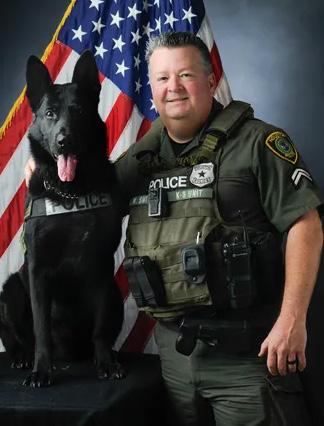

Dogs are man’s best friend for a reason. They are loyal to a fault. They do not judge. They love unconditionally. They work as service dogs in hospitals, bringing smiles to patients’ faces. Dogs also work as service companions for those with post traumatic stress disorders. These furry friends can even sense when their owner is about to have a seizure and can help alert and prepare them for what to expect. Canines are an integral part of our military, fighting alongside our soldiers near and far. While this list is only scratching the surface of their capabilities, it is clear that dogs are an invaluable asset, as well as companion, to humans.
It was an unseasonably warm Monday in February when I made the drive to Huntsville, Texas. The first thirty minutes of my K9 training interview flew right by, as good ones always do. I jotted down notes while listening intently, until the trainer stood up and approached a door located in the corner of the room. As the door swung open, Jett, a handsome but intense five-year-old German Shepherd entered the room. His eyes darted quickly around the room with a sense of purpose. His tail wagged low, showing excitement but also that he was alert. With a quick sniff, surely smelling my dogs back home and the popcorn I ate on the drive to the interview, he acknowledged me as harmless and moved on. Jett was all eyes for his owner handler.
but loyalty and respect make aHandler Greg Smith and his K9 Jett
My interview that day was with Greg Smith, the owner of Integrity K9 Texas, a Huntsville business that purchases and trains police K9s. Greg worked with the Houston Police Department for twenty-five years, sixteen of which were spent as a K9 officer. Having firsthand experience in the field is an integral reason why departments see Greg as a top notch, reliable trainer.

My question was how does one train a dog physically and prepare a dog mentally for such a demanding career as a police K9? Additionally, I wanted to discuss the trust and respect a dog and its handler must have for one another to be safe and successful in their careers.

In the police world, dogs are divided into single-purpose and dual-purpose careers. Single-purpose dogs search for explosives and work in odor-related fields, like narcotics or search and rescue. They tend to be Labradors, German Shepherds, German Shorthair Pointers, and Retrievers, because these are breeds known to have a good hunt drive. Dual-purpose dogs work in both odor and patrol, and they are often Belgian Malinois, German Shepherds, and Dutch Shepherds. These three breeds are all highdrive working dogs.
Everything starts with selection. “We are looking for bloodlines, for pedigree,” says Greg. Europe’s bloodlines and breeding practices are more stringent than those in the United States, resulting in exactly what trainers like Greg are looking for. Observation and testing begins almost immediately after the pups are born. With small bite pillows, tests of courage, and extensive vetting, the breeders are monitoring them closely. Out of a litter of maybe 6-8 puppies, only one or two will demonstrate the aptitude for police work. The remaining pups will go into the line of sport competition or become the pets we know and love.
Trainers watch this process from afar, thanks to pictures and videos from the breeders. Every trainer has a checklist of traits they are looking for. Greg only purchases social dogs. “The vicious dog that wants to hurt everything in sight won’t make it on the job at the end of the day.” The liability is too high for the police department, and it ultimately becomes an officer safety issue. Accidental bites are the number one reason a K9 department is sued.
Greg typically selects up to eight dogs at a time from countries like Holland, Germany, and Czechoslovakia. Immediately after selection, the dogs are put on a plane, and he eagerly awaits their arrival at the airport.
After a long flight, the dogs need some time to get settled and acclimated to their new surroundings. Most of these young dogs have never seen stairs before, or even been inside of a building where sounds echo and bounce back at them. After acclimating, it is time to get to work.
K9s are trained in the language of the country where they originated. Not only is this familiar to them, but it results in

less confusion as to where the command is coming from. It would be a horrible day for everyone if the bad guy was able to give commands to the K9 on the streets.

“We start with environmentals,” notes Greg. “My facility is an environmental nightmare. It has everything a dog hates: grated walkways, slick floors, and loud echoes.” An agitation table is used to build up a dog’s confidence. This is where the dog is atop a table, now eye level with the human, and strapped in from behind. The human initiates a fight with the dog and, after going back and forth for a while, the human surrenders - resulting in a confidence boost for the dog.
Odor training is also very important. Greg uses a pizza analogy that really helps break down what trainers are trying to accomplish. “When you walk into a pizza place, you smell pizza. We start with the pizza but, by the end of training, our dogs need to be able to walk in and smell the oregano, the basil, and the tomatoes – all the components of the pizza, individually.” Over the course of many weeks, the dogs undergo various puzzles and games to help hone their sense of smell. Greg gives his dogs six months to demonstrate their abilities. The number one reason why a dog is disqualified is courage. If a dog backs down from a fight, or runs from the situation, that will manifest itself on the street. “I’m a dog lover,” Greg says. “But, I am also a dog handler, so I have to be practical. I
cannot let my heart get in the way of the decisions I have to make regarding each dog, or they would all end up living at my house. Every dog has a purpose, and if it is not K9 work, I will help find what that purpose is.”
After a department chooses a dog, training does not stop; it becomes even more important. There are handler courses all over the country that help train an officer and K9 to work as a team. At Integrity K9 Texas, Greg offers a nine-week training for dual-purpose dogs, and a fourweek training for single-purpose dogs. During that time, the dog and officer live at his facility, training a minimum of eight hours every weekday. Initially, two strangers walk in and, ultimately, a unified pair walks out.
The handler and K9 must learn each other’s nuances or subtleties. It could mean the difference between life and death. For example, when the dog is searching an area for a runaway fugitive and he approaches the scent cone, often referred to as fringe, the handler might see his dog with his nose to the ground moving in a zigzag pattern. The handler is watching to see when the dog reaches the target, or source. Each dog is different, but
Former Fulshear Police K9 Belle.the handler will see the dog’s body posture change and the breathing both increase and intensify. Trainers help handlers and dogs learn these intricacies about one another and begin the building blocks that result in a strong and unified team.
K9 trainers work hard to install a switch into these dogs, so that they can be police K9s at work, but also safely be around an officer’s friends and family during days off at home. Jett, while retired from police duty, helps Greg train other up-and-coming K9 recruits during the day and curls up on the couch with him and his wife at night. Good training is what makes this possible.
Training does not stop after completing the handler course. In fact, it is only the beginning. Many K9 officers, in addition to daily and weekly training, attend a 40-hour seminar each year. This is where officers and their dogs can familiarize themselves with the latest technology and hone their skills in scenarios like tracking narcotics and fugitive apprehension.
According to Greg, the biggest hurdle a K9 and its handler have to encounter is their first engagement. “It is the real testament to whether what was learned in training can transfer to the streets.” On average, it takes about a year for this duo to fully click, to be able to predict their partner’s behavior and next move. That being said, once this bond is formed, it is impenetrable. “We are with our dog more than we are with our own families,” Greg admits. “We are with them at work and we are with them at home.”
Greg never leaves his partner’s side. On numerous occasions, that has meant sleepovers at the vet. “That’s my partner. We have been through so much together. It’s ride or die.”
While the dog is a tool in an officer’s toolbox, that tool does not need to be used on every call. But when the dog is needed, the officer pushes the button on their belt that opens the squad car door to release their best friend and partner. With that decision comes the reminder that the dog may not make it back home with you at the end of the day. “These dogs do not think twice about entering into dangerous situations,” Greg says, pragmatically. “They simply do what they are trained to do. They are loyal ‘til the end.”
For all of Greg’s K9s, the best reward for a hard day’s work catching bad guys is a Frosty Paws doggy ice cream treat. The best reward for a K9 officer, after a long day on the streets, is returning home safe and sound with their loyal partner by their side.

A K9 and their handler are partners in every sense of the word. Their bond is no less significant or less important because it is a human and a dog – in fact some might argue that it is stronger. The love Greg has for his dog Jet is palpable. But, as I saw firsthand during our interview, that love goes both ways.
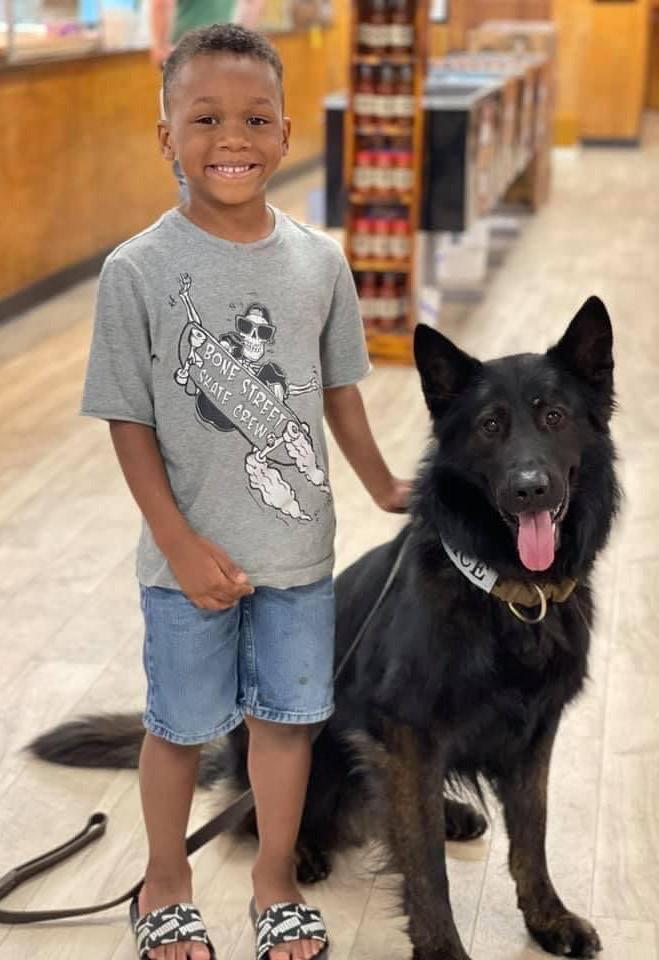
Fun Fact: Tear gas does not affect dogsPolice K9 Jumbo & Lieutenant Segura Fulshear police K9 Blu with a new best friend.
K9 officer information
Get to know some of your area K9s and handlers!

•
Blu’s favorite toy in the whole world is his yellow Durafoam ball with a rope. There have been times that he has turned down food for the ball.
I enjoy working with Blu every day, but I truly believe he enjoys it too. When he sees me loading up the car in the morning, he starts to go crazy by barking and spinning around. He can’t get his collar on fast enough. We have a specific routine every morning, and I think he counts on that.
I think one of the funniest stories is the time that he pushed the partition door open from his part of the car and got in the front seat, ate my lunch, shredded all of my paperwork, and then took his ball and a brandnew box of masks back to his part of the car, where he shredded the ball and spread the masks everywhere. I was convinced that day that he was part mouse, because the opening in the door is not very big.
I think the hardest part about being a canine officer is knowing that your dogs are tools, and you have to send them in first before you send the officers in, and there’s potential that they may not come out.
 officer Jennifer Edmonds
officer Jennifer Edmonds
Handler
- Fulshear Police DepartmentK9: Blu
AGE: 5 | BREED: Belgian Tervuren
PLACE OF BIRTH: Poland | YEARS PARTNERED: 2
K9 SPECIALIZATIONS: Narcotics detection, tracking handler, protection, fugitive apprehension, evidence search
I think some of the important things I’d like people to know about our job is that it’s absolutely rewarding, and there’s so much work and dedication that goes into it. And not only are these dogs our partners - they also become family members and play important roles in both places.
Officer James Edge
Handler - Lamar CISD Police Department


K9: jumbo
Donated by K9Officers.org to LCISD | AGE: 2 | BREED: Malaherd (German Shepherd/Malinois) | PLACE OF BIRTH: Hungary
YEARS PARTNERED: 1 | K9 SPECIALIZATIONS: Narcotics/ WeaponsTrained by HK9 Academy

• Jumbo’s Favorite Things?
Jumbo’s red Kong toy, peanut butter, and bones
• How About Your Bond with Jumbo?
Jumbo is the most loyal and best partner I have ever had. I feel we are still learning about each other, but it makes getting up to go to work every day that much better. I know his wants and needs, even without him being able to talk. Plus, it’s hard to call in sick when you have a K9 that counts on you.
• Funny Stories on the Job?
While doing an elementary school visit, a student made the comment that he had never seen or touched a police K9 before. After petting Jumbo, the student then told me he was never going to wash his hands again.
• Hardest Part of the Job?
It’s a 24Hour/7 day a week job. When we get off work, we are technically still working, feeding, maintaining, exercising, etc.
• What You Wish People Knew?
Being a K9 Officer is not just a job - it’s a lifestyle. You must change your schedules, family activities, and way of life. But it brings joy and happiness every day.
• Hero’s Favorite things?
A day at the spa! This is where he gets a bath and deshedding. It’s the only time he really leaves my side. He begins to act like a loving pet instead of a Police K9.
• How About Your Bond with Hero?
We have a very close bond. Hero and I have a similar mindset; it’s all about eating food and finding contraband. But he also enjoys running around my house and playing with my children.
• Funny Stories on the Job?
When Hero and I first became partners, I arrived at my house and let him out of the patrol vehicle off the leash, thinking I could control him with verbal commands. Little did I know that I would soon be running around my neighborhood chasing my new K9 partner through the front and backyards of random peoples’ homes. This was not funny at the time; however, thinking back on it, it’s extremely funny to think about me in full uniform chasing a dog at 3 am.
• Hardest Part of the Job?
I love every aspect of being able to go to work with my K9 partner and cleaning the streets of narcotics. But if I had to pick something, it would be the fact that I am on call 24/7, 365 days a year. I get woken up in the middle of the night often.
• What You Wish People Knew?
Hero is more than just a police dog. He has his own personality and is very intelligent and loving to my entire family.
Sergeant Robert McQurter
Handler - Katy Police Department
K9: hero
AGE: 7 | BREED: Belgian Malinois | PLACE OF BIRTH: Unites States | YEARS PARTNERED: 6
K9 SPECIALIZATIONS: Detection of the following narcotic odors: Marijuana, Methamphetamine, Heroin, and Cocaine

Like most of you, I’ve always been enamored by the sheer beauty and seemingly weightlessness of butterflies. When we see them flutter by, we wonder how they don’t get swept away by a strong gust of wind; or we may wonder where they find shelter when it rains.
Most school-aged children, and adults too, are familiar with and have fallen in love with the classic book by Eric Carle, The Very Hungry Caterpillar
This is not a story about me, but I must give you some context, so you will understand why I am so absorbed with the topic. In 2016, after seeing the IMAX 3D feature film “The Flight of the Butterflies” at the Bullock Museum in Austin, Texas, I was hooked! It was a beautiful love story. The film was mainly about the Monarch migration to Michoacan, Mexico, and the husband-and-wife scientists and team who had been studying the Monarchs for decades. In February of 2022, my dream came true; and I was blessed to be able to travel to Michoacan.
The experience was … well, what I imagine heaven must feel like.
 Beautiful Monarch Butterfly exploring Cross Creek Ranch
Beautiful Monarch Butterfly exploring Cross Creek Ranch
There are more than 17,000 species of butterflies, globally, and over 750 species in the United States. But the Monarch, as majestic as its name, was classified as an endangered species last year by the International Union of Conservation of Nature. This union is considered the world’s most comprehensive scientific authority on the status of species. However, their population can fluctuate from year to year. A few of the reasons the Monarch species has become endangered are due to unstable global weather conditions, their tiring journey from North America to Mexico, harmful pesticides used for gardening, and butterfly predators like red ants. Peggy May, marketing manager, and Ashley Grubb, garden consultant and entomologist, (expert on insects and their environment) who work at Enchanted Gardens landscape and garden center, tell us we must be very careful with the chemicals we use to treat our yards. In addition, if enthusiasts are interested in planting a garden that attract monarchs or other butterflies, they must take into consideration what other critters might be attracted to the plants they grow, as well, and be committed to supporting a balanced ecosystem.


Each year, close to twenty million monarch butterflies begin their 3,000-mile journey from Canada and the USA to Mexico. The Monarch is the only butterfly that migrates north and south every year. About half a million monarchs pass through Texas, and anywhere between 20,000 to 200,000 migrate to California. There are two populations of Monarchs that call the United States home. The larger group living east of the Rocky Mountains migrate south to Mexico. And those living west of the Rockies migrate to the coast of central and southern California. Instinctively, in late September and early October, the monarchs know they must fly south to escape freezing temperatures. The migration season typically begins in October and ends in March. Sadly, not all of them make it, and no single monarch makes the trip in both directions. Monarchs generally live five weeks, with a range of two to six weeks during the summer months. Scientists say the first three generations of monarchs live around four to six weeks flying, breeding and eating. But the migratory monarchs, the fourth generation, live six to eight months, and it is this generation that flies the longer journey! The Super Monarch, I call it.

 Ashley Grubb and Peggy May, Enchanted Gardens Employees
- Photo by Dawn Benjamin -
Monarchs roosting on a tree stump at the Rosario reserve.
Photo by Dawn Benjamin
Photo by Jaclyn Ritter
Ashley Grubb and Peggy May, Enchanted Gardens Employees
- Photo by Dawn Benjamin -
Monarchs roosting on a tree stump at the Rosario reserve.
Photo by Dawn Benjamin
Photo by Jaclyn Ritter
(281) 341-1206
6420 FM 359 • Richmond, TX 77406
EnchantedGardensRichmond.com
RECOMMENDED BOOKS: “Monarchs And Milkweed” by Anurag Agrawal “Butterfly Gardening for Texas” by Geyata Ajilvsgi “Butterflies of Houston & Southeast Texas” by John & Gloria Tveten
ONLINE MONARCH RESOURCES: www.flightofthebutterflies.com www.acloserlooktours.com http://www.thestoryoftexas.com https://www.hmns.org/cockrell-butterfly-center/pollinatorgardeneing/monarch-butterflies-in-houston/ www.monarchwatch.org
MONARCH BUTTERFLIES OF PISMO BEACH CALIFORNIA: https://www.experiencepismobeach.com/beach-and--outdoors/ monarch-butterflies/#.ZBAbPdQ8oZE.mailto




 LEFT: Enchanted Gardens #milkweed movement corner. RIGHT: Caterpillars at the Enchanted Gardens nursery sitting on Asclepias, also known as butterfly weed. BELOW: Local monarchs enjoying a moment of rest at Moody Gardens in Galveston, TX. - Photos by Dawn Benjamin
LEFT: Enchanted Gardens #milkweed movement corner. RIGHT: Caterpillars at the Enchanted Gardens nursery sitting on Asclepias, also known as butterfly weed. BELOW: Local monarchs enjoying a moment of rest at Moody Gardens in Galveston, TX. - Photos by Dawn Benjamin
RECOMMENDED PLANTS FOR MANY LOCAL BUTTERFLY SPECIES

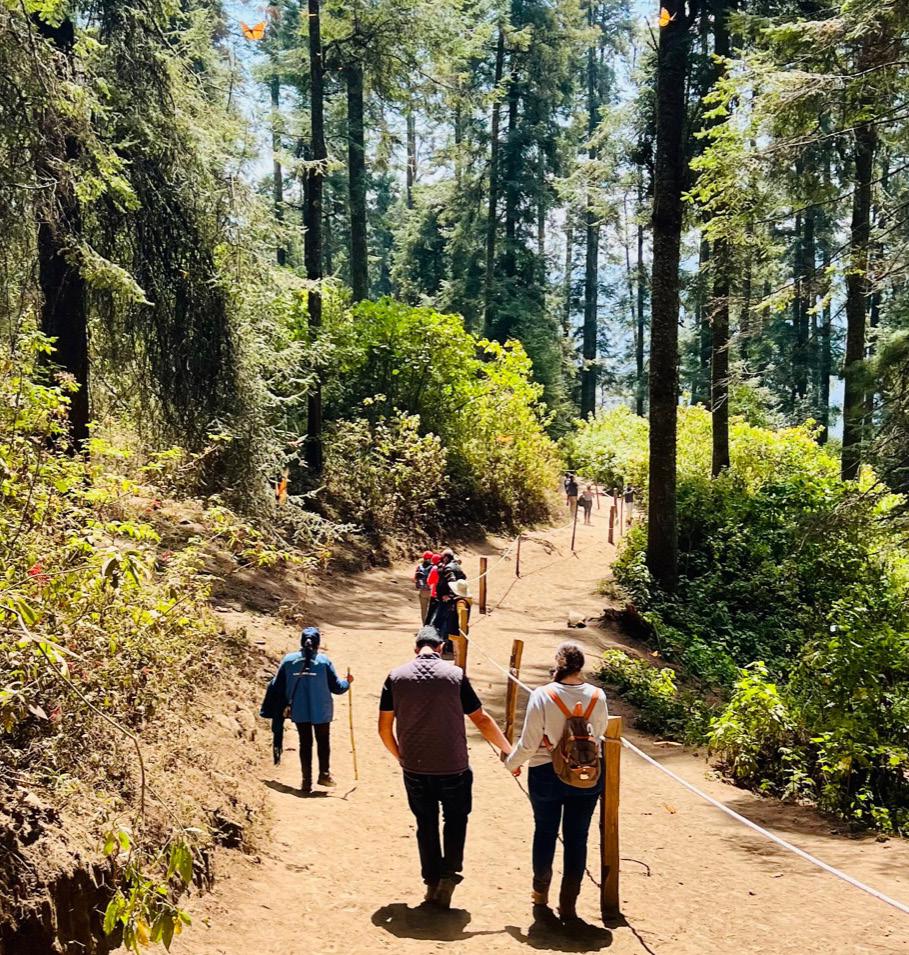

NECTAR PLANTS: Blanket Flower, Gaillardia • Duranta • Greg’s Blue Mist Flower • Lantana • Yellow Cestrum • Zinnia
HOST PLANTS: Milkweeds • Passionflower Vines • Parsley • Fennel Dill • Cassia Species • Citrus • Rue • Hercules Club
 TOP LEFT: Monarchs waking up fluttering in the afternoon sun in the Oyamel forest. TOP RIGHT: Tourists and guides trekking to the Oyamel forest. BOTTOM LEFT: Mineral de Anganglueo – El Monumento (town sign). BOTTOM RIGHT: Monarch Butterflies on tree branch, Michoacan, Mexico.
Photo by Dawn Benjamin
Photo by Dawn Benjamin
Photo by Dawn Benjamin
Photo by JHVEPhoto - stock.adobe.com
TOP LEFT: Monarchs waking up fluttering in the afternoon sun in the Oyamel forest. TOP RIGHT: Tourists and guides trekking to the Oyamel forest. BOTTOM LEFT: Mineral de Anganglueo – El Monumento (town sign). BOTTOM RIGHT: Monarch Butterflies on tree branch, Michoacan, Mexico.
Photo by Dawn Benjamin
Photo by Dawn Benjamin
Photo by Dawn Benjamin
Photo by JHVEPhoto - stock.adobe.com
Entomologists believe that migrating monarchs have longer and heavier wings than the monarchs who have not begun the migration course.
Most monarchs arrive at their roosting, (location of resting and shelter) in November. In Mexico, the monarch butterflies, or mariposas monarca, prefer the tall Oyamel fir trees. The humidity and mild temperatures assure the monarchs won’t dry out; the trees give them protection from predators and the elements; and they cluster together to stay warm and blanket the tree limbs. Tens of thousands of monarchs can cluster on one tree. To see this in person is nothing short of breath taking. Piedra Herrada is the easiest sanctuary reserve to access from Mexico City, Mexico by car or bus. The drive is about two to three hours long. The other three sanctuaries, Rosario, Cerro Pelon, and Sierra Chincua are in the state of Michoacan.
The elevation to this region of Mexico is about 10,000 feet higher than Mexico City. Tourists can visit the Monarch sanctuaries once they arrive, either by foot or on horseback, making this a thrilling but quiet morning trek. The monarchs are still until around noon, when they wake up from the warmth of the afternoon sun by the thousands, to flutter about in gaiety throughout the forest; yet another beautiful sight to behold.
In California, the monarchs prefer eucalyptus, Monterey pines, and cypress trees.
If you are interested in helping the monarch population grow, please consider growing and cultivating a garden of your own for them and other butterflies. I caught up with a few “Fort Bend County Master Gardeners” who were giving a presentation at the Ft. Bend County Library in Mission Bend branch.
Here are a few tips they gave: Plant a variety of plants, both host and nectar. While the monarchs prefer to lay their eggs on numerous leaves, other butterflies may leave all their eggs on one leaf; but all species are attracted to a colorful garden. One of the monarch’s favorite plants is the milkweed. Make sure you have healthy soil, and select plants that bloom at different times of the year, and be sure to remove worn out flowers to encourage new blooms. Also, remember to plant aromatic flowers near bushes and trees in your yard to provide additional shelter for the butterflies from inclement weather. The master gardeners also agree with Peggy May and Ashley Grubb that butterfly gardeners should never use pesticides! Peggy and Ashley assure that all milkweed grown by Enchanted Gardens has not been sprayed with any insecticides or other chemicals. They advise to use native milkweed or tropical milkweed, but to keep in mind that native milkweed goes through periods of dormancy, and tropical milkweed can remain green year round.
Whichever recommended plants you decide to grow for your butterfly garden, you will be sure to enjoy other wildlife like humming birds and dragonflies, that will be drawn to your handiwork and green thumb. Plus, of course, the monarchs of every generation will be most grateful.


Asa travel advisor, exploring the world and helping others do the same is my job. The more destinations I visit and cruise lines I experience, the better my agency can serve our clients. Typically, I take solo trips or trips with other advisors, but when an opportunity to sail down the Danube on Avalon Waterways came along, I asked my mother to join me. Given her age and a desire to visit Eastern Europe, a river cruise seemed like a great fit for her. After all, anyone who has ever watched PBS knows river cruising is for the older generations and retirees, right? Wrong. Absolutely wrong. The truth is, my 44-year-old, independent-traveler-self fell absolutely in love with river cruising!
Having only ever cruised on vast ocean waters and not considering myself a real “cruiser,” I did not realize how different the overall experience would be. Sure, I expected the gloriousness of only having to unpack once like I would on an ocean cruise, but I did not expect to be onboard a smaller ship with a bunch of people my age, to dance each night away in the main lounge, or to desire to return to another river cruise, as soon as possible.


From the moment we exited our taxi at the boat dock, we knew we were in for an incredible experience. Three strapping crewmen, one of whom I later realized was our captain, greeted our vehicle with open arms and friendly faces. Before I had even paid our taxi driver, our luggage had been removed from the trunk and whisked away to our stateroom. Five minutes later, after we checked in and made our way to our room, we found our suitcases at the foot of our beds.
 Bartender Alex Viola and Captain Thijs van der Lee
Bartender Alex Viola and Captain Thijs van der Lee
As our daily interactions with the staff increased, we learned some of the staff members’ stories – where they were from, who was waiting for them back at home, and their career aspirations. They learned our names, ensured we had everything we needed, and even joined us on the dance floor some nights after their shifts.
Midway through the week, the staff surprised us with a delicious, late-night offering of Goulash, a traditional Hungarian soup, served casually in the main lounge area. The next day at lunch, as the executive chef handcarved perfect slices of beef tenderloin, we gushed about the Goulash. He was honored we had loved the soup. He told us it was his own family’s special recipe that had been passed down from his grandmother. Two days later, we opened the door to our room to find a handwritten note that someone slid under the door. Within the note was the Goulash recipe - handwritten just for us by the chef - and with personal notes in the margin.
While, I have had plenty of excellent experiences with friendly staff aboard ocean cruise liners and on group tours, I have never received such warm-spirited personal service and attention as I did from the crew onboard the Avalon Visionary.


One of my favorite aspects of river cruising is simply the convenience of the overall experience. Essentially, your “floating hotel” delivers you to the doorstep of the port cities on your itinerary. Pair that with the ability to check in or out of the boat with the scan of a key card and a 10-second walk down a gangway, and you are in the heart of your destination within minutes of leaving your room. This allows for more time to explore your destination and less time spent walking to and from the ship. Plus, who wants sore feet? Not me.
Additionally, river boats are tiny compared to most ocean ships. For example, Royal Caribbean’s fleet holds anywhere from 2,400 to 6,988 passengers, whereas the Avalon Visionary holds 130 total passengers, 35 of whom are crew members. The ship has only four decks (including the observation deck on top), one main lounge, one main dining room, and a smaller lounge at the back of the ship. Running late for lunch with new friends in the dining room? No problem! You only need about a minute to get there from anywhere on the ship.
Unlike ocean cruising, where international buffets abound and all-night pizza stations are the norm, river cruising takes a different, dare I say, sophisticated-without-beingstuffy approach. Typically, each ship has an executive chef who prepares new culinary delights each day. Due to easy access of local produce and markets along the route, the crew stocks up on local supplies as you sail. If white asparagus is in season and sold fresh locally, and if you should choose it from the many options on the menu, you’ll find it artfully prepared on your plate that evening. As a bonus, if you are a wine lover, every meal is paired with a recommended regional selection.
We fell hard for the off-the-menu Belgian waffle, the daily, fresh-made ice cream at lunch, and the flavorful soups and main courses at dinner. The hardest part of every meal was deciding from the vast variety on the menu what to order. Fortunately, the staff was happy to help by bringing two entrees…if choosing just one proved too difficult.
A Few Key Members of the Visionary’s Fabulous Hospitality Team - Igor Crnac, Chef Adrian, and Eduard Nedelcu




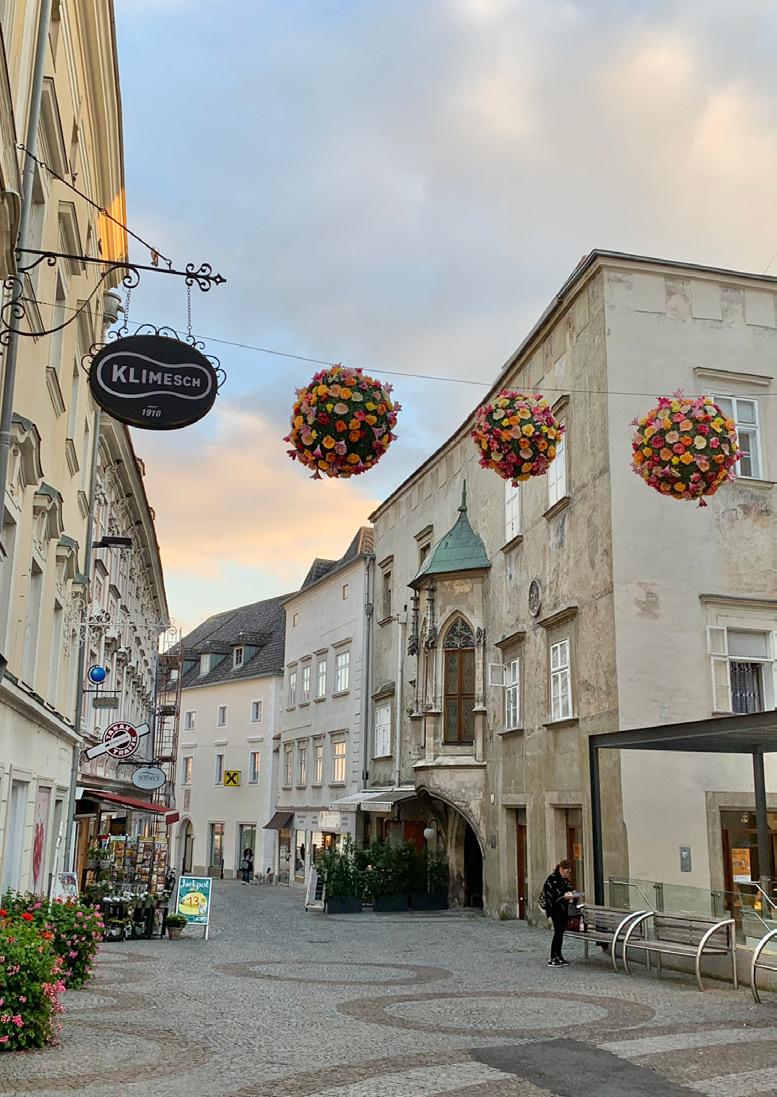

While onboard a river cruise, the focus tends to be on relaxing and enjoying the scenery as you sail along. For this reason, Avalon has positioned the beds in each suite to face the floor-to-ceiling window (which also happens to slide open, turning your room into one huge, plush balcony). You can literally lie in bed and watch the world go by at your feet.
On the other hand, your time spent off the ship tends to be more about immersing yourself in the local culture while seeing the sites. For this, companies like Avalon offer several exploration options for all traveler types. From hikes to bikes to slow-walking tours, everyone can find a way to personalize their own experience and get the most from their time onshore.
I’m not sure exactly how it happened, but I ended up on a 17-mile bike ride one morning after breakfast and, as I rode along with the rest of our small group, I watched our ship sail on to the next port town. Part of me was panicked. What would I do if I wasn’t able to make the full trek? After all, there were hills! However, the rest of me was thrilled to be cruising up and down the Austrian countryside, chatting with my fellow risk-takers. Some of those go-getters even managed a castle hike the next day. I, however, decided once again to watch the world go by at my feet.
The most unforgettable, goosebump-inducing moment on our Danube cruise occurred during our last night onboard. Originally, we were supposed to arrive in Budapest (our final stop and disembarkation point) sometime after midnight. While we prepared for our divine dinner of surf and turf, our captain reviewed

the sailing schedule and made a surprise adjustment. Unbeknownst to us, due to an energy crisis in the EU, European cities were turning off all unnecessary city lights two hours earlier than usual each night to preserve resources. Included in this shutdown were all the lights illuminating the gorgeous Hungarian Parliament Building and the architecture of Budapest, one of world’s most undeniably beautiful cities at night. We sailed along with no idea that the city was scheduled to go dark before we would ever see it.
After dinner, our Captain announced his intent to sail us into the city a few hours earlier than scheduled. His crew had already been working on getting us there sooner. A few hours later, we were all invited to grab our blankets from our rooms and join the crew on the observation deck. We were then handed champagne and asked to make ourselves comfortable while our Cruise Director, who happened to be from Budapest, gave us a personal introduction to the history and cultural significance of her homeland.
I will never forget the moment the Parliament building, in all its beautifully lit and radiant glory, came into focus from the center of the river. It was truly breathtaking. I even teared up, overwhelmed by the uniqueness of the moment. For the next minute or two, I snapped as many photos as I could. Then, just after we’d passed the Parliament – darkness. We’d made it just in time to capture the moment for a lifetime.
River cruising is my new favorite way to travel, and I cannot wait to do it again. In fact, I’m planning a couple of group trips later this year and in 2024. Interested in joining me? Contact Happy Tracks Travel at info@ happytrackstravel.com or 832-507-2030
www.happytrackstravel.com
SPECIAL INTEREST:
• Christmas Markets
• Wine Appreciation
• Beer Tasting
• Historical
• Culinary
• Garden & Nature
• Jewish Heritage
• Photography
DESTINATIONS:

• Mekong River, Asia
• Nile River, Egypt
• Amazon River, South America
• Ganges River, India
• Mississippi River, USA


 WRITTEN BY SUSAN LOWE-STRICKLAND
WRITTEN BY SUSAN LOWE-STRICKLAND
What weighs 1/40 of a pound, is fastidiously tidy, provides worldwide food security, has among the most sophisticated form of animal communication outside of primates, and is pretty darn good at dancin’ in the dark?
Honey bees are the only insects on earth known to produce food for humans. They are one of the world’s most critical pollinators and, in fact, help over 90% of all crops to reproduce. They have baskets on their legs to carry pollen and, by transferring these tiny microspores from one flower to the next, the plants they visit are able to produce fruits and vegetables. Plus, within their hives, they produce honey—an all-important food source that is used as a natural sweetener, antiinflammatory, antioxidant, and antibacterial agent for humans.
With bees, though, it’s really all about the Colony, a staggeringly intricate network of community organization and collective intelligence. Within a hive

Without these busy little bees, the world would be a very different place.Photo by Raymond Choo
of 20,000 to 80,000 bees are thousands of workers, drones, and a queen—all working together to create the perfect environment for producing all-natural honey. Each hive has one queen and 100 female worker bees for every male drone bee. The queen’s only job is to lay eggs, a male drone’s job is to mate with the queen, and the female worker is responsible for everything else—gathering nectar, guarding the hive, caring for the queen and larvae, keeping the hive clean, and producing honey.

The unique design of honeycombs, coupled with the constant fanning by the bees’ wings, causes evaporation of water to take place, which creates the thick sweet liquid we know as honey. The bees then seal the honeycomb cells with wax caps. Beekeepers pull out the frames, then strain them to remove any wax or particles found in the hive. The


Bees travel to as many as 100 flowers each time they make a trip out of the hive. The nectar and pollen collected is brought back to store in honeycombs, which are perfect hexagons that are considered one of the most efficient structures in nature.Photo Courtesy of Monica Siwiak
final step is to pour the honey into jars. Depending on the blossoms the bees visit, the color and flavor of honey can differ greatly. On average, one hive will produce about 65 pounds of honey each year.

Queen bees, genetically, are exactly identical to worker bees. But they are fed a different diet from the time they are tiny larvae until the day they die. This different meal plan causes their physiology and behavior to develop completely differently from worker bees, despite the same genetic foundation.
Royal jelly is a protein-rich excretion from the glands of worker bees – sort of a honey bee’s version of mother’s milk. While all larvae are fed royal jelly for the first three days of life, larvae chosen by the worker bees to become queens are bathed in royal jelly in special, elongated ‘queen cells’ throughout their development. After the larval stage is complete and the queen bee emerges, she is fed royal jelly throughout her life.
The first queen to emerge will sting the other developing queens through their cells, killing them before they can hatch. If two or more queens hatch at the same time, they will fight to the death!
In the hive, the queen’s main role is reproducer in chief She will control the size of the hive, laying more eggs in preparation for Spring and Summer, and slow her laying in preparation for the cooler months when there’s less work to do and less food around. In the height of the Spring, the queen can lay up to 2,000 plus eggs a day. This is more than her own body weight in eggs! Fertilized eggs will be workers or queens and unfertilized eggs will be drones.
The queen is always surrounded by a circle of devoted workers who feed her constantly and dispose of her waste. Also, her queen pheromones are unique. No other queen smells the same. The attendants collect and distribute her queenly pheromones throughout the hive, letting all the colony’s residents know that their queen is alive and well. When workers can no longer smell the pheromone at a sufficient “per bee” concentration, they know it is time to raise a new queen.
Excellent communicators, bees have the most sophisticated form of animal communication outside of primates and use both smell and movement to convey messages. Beyond their ability to inform the hive of the queen’s viability, they also have a secret language that communicates where to find the best flower patches.
In 1946, Karl Von Frisch, a Nobel Prize-winning ethologist, made an amazing discovery that, when a bee finds a good source of nectar or pollen in a flower, she will return to the hive to perform a dance to “tell” the other bees how to find those same flowers. Flying in a figure eight pattern called the Waggle, the dance tells the other bees in the hive two things about a flower patch’s location— the distance and the direction away from the hive.
To motivate other bees to find the correct flower patch, the dancing bee shares a sample of nectar she collected. First, she gathers an audience by climbing on her sisters’ backs and vibrates her abdomen. She then regurgitates a sample of the nectar that was stored in her honey stomach for them to taste.
To indicate Distance, the dancing bee waggles back and forth as she moves forward in a straight line, then she circles around to repeat the dance. The length of the middle line, called the waggle run, shows roughly how far it is to the flower patch. The longer she waggles,

the farther the flower patch lies from the hive. A more invigorating waggle can even tell the other bees the quality and richness of the source.

To indicate Direction, the dancing bee tells her hive mates how to use the sun as a guide to the flower patch. These fascinating insects see the world differently from the way we humans do; they can see colors we cannot, including ultra-violet light. In addition, because bees contain an inner solar compass, a sort of built-in GPS that always points them toward the sun, they can even estimate its position as it travels across the sky and can take into account changes in seasons and latitudes.
If the dancing bee moves straight upward, the bees know to fly straight toward the sun when they leave the hive; if the bee dances 90° left, the bees know to fly 90° left of the sun when they leave the hive; if the bee dances straight down, the bees know to fly away from the sun when they leave the hive.
Honey bees, it turns out, are also pretty good at dancing in the dark. Worker bees don’t actually see the waggle dance, because the hive is pitch black. Instead, they sense air vibrations through their antennae, which are held close to the dancing bee.
Many people fear bees, when what they should fear is a life without them.
Bees are part of the biodiversity on which we all depend for our survival. When bees thrive, so do crops; when crops thrive, so do we.
Could you imagine walking into your grocery store and not seeing the shelves lined with food? Without these pollinators, there would be few fresh fruits or vegetables. There would be no products containing honey, almonds, coffee, or chocolate. Without bees, even milk and beef would be in short supply, because pollinators are responsible for plants like alfalfa that feed cattle.
So, take a step back to look at why bees are important to human life; the answer is very clear. Bees are a cornerstone of our food system and, along with other pollinators, they help support the plants that provide the very air we breathe.
There are some simple steps that we can take to further the survival and flourishing of these amazing tiny creatures. We can use only pesticides that do not harm bees, and we can spray them in windless weather, either early in the morning or late at night, when bees are not visiting blossoms. We can grow bee-friendly flowers. Check with your local nurseries to learn the best flowers to grow for our area’s bees. If we protect the bees, we take a huge step toward taking care of our planet and serving as good stewards for our world.
 Photo Courtesy of Monica Siwiak
Photo by DirkDaniel - stock.adobe.com
Photo Courtesy of Monica Siwiak
Photo by DirkDaniel - stock.adobe.com

There’s a new game in town, y’all; and, as they say, it is sweeping the nation by storm. And, just who are they? Well, they are sports enthusiasts, celebrities, fashion designers, real estate tycoons, media executives, adolescents, and Miss Jane down the street! I could go on and on . . .
But wait, this game is not new at all. In fact, it has been around for more than 50 years. Yep, that is right. So why the sudden interest, craze, explosion and, might I add, phenomenon?
One cannot describe this game as JUST A FLEETING FAD; it has been around too long. And yet, pickleball is said to be the fastest-growing sport for the third consecutive year since 2019.
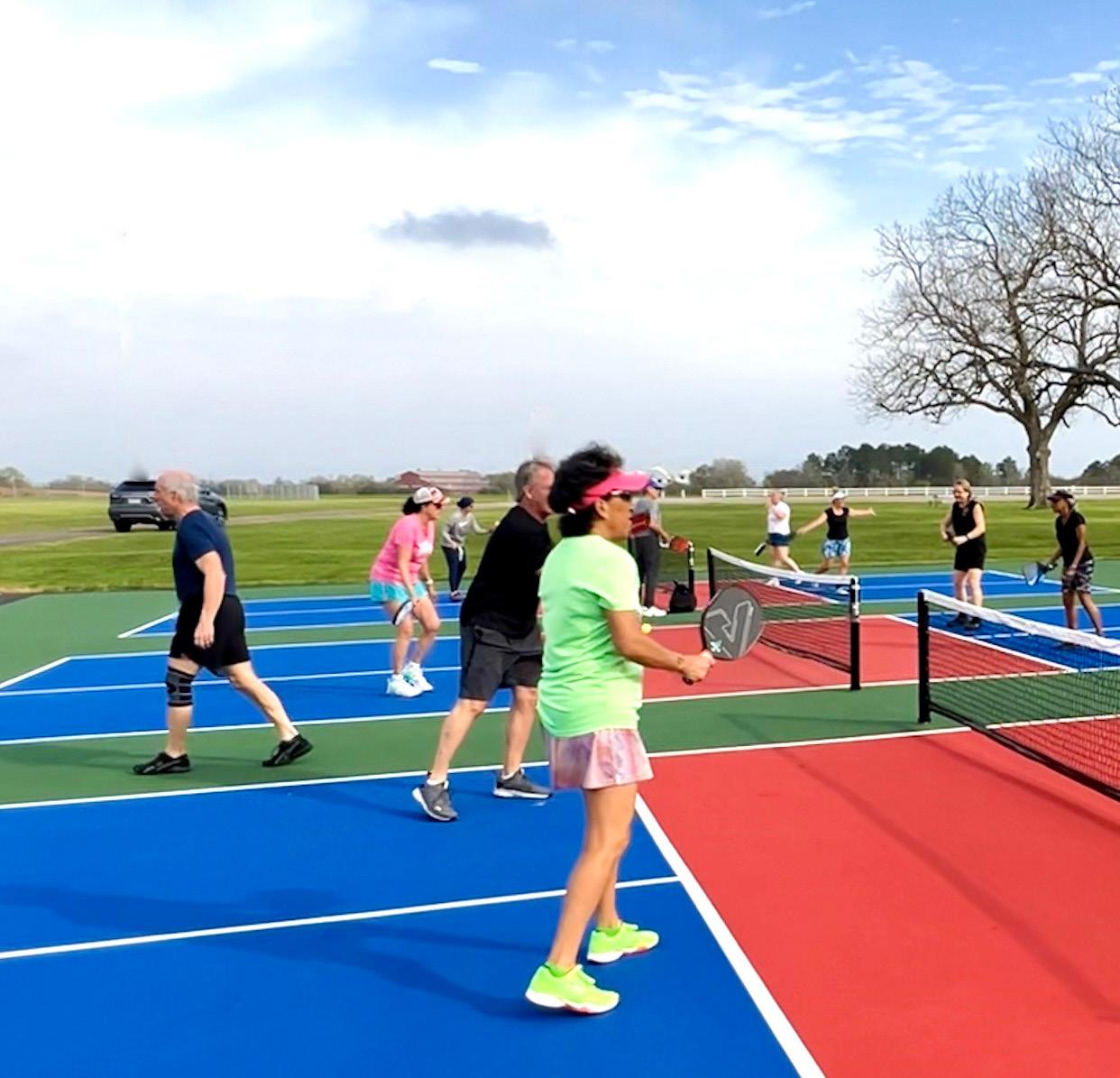
It has been especially popular with adults 55 and older, but now the average age of all players has dropped to 38 years of age, according to USA Pickleball, the national governing body for the sport in the U.S. Between 2020 and 2021, the fastest growth of participants in the game was under 24 years of age. And 85 – 90% of all the players enjoy this sport purely for recreation.

No, this feels different, and we may not be able to fully explain it. But, if you are unfamiliar with the sport and hungry for information or details, we will try to give you a few tidbits.

Did you know that the pickleball game was created by family friends, the Pritchards, McCallums, Smiths, Bells, and Browns in Washington State in 1965? It is said that young Frank Pritchard, the son of Joel Pritchard, was bored that summer while on a family vacation and complained that he and the neighboring kids had nothing to do. This new game was first crafted on the family’s badminton courts in Banbridge Island with badminton racquets, paddleballs, ping pong paddles, and ping pong balls—pretty much using anything that was laying around! However, since then, the game has been perfected, has its own set of guidelines and etiquette, and is played all over the world with finesse!

Oh, and the name? Well, it is said that Frank’s mother Joan said the game reminded her of the rowing term “pickle boat,” which meant a hodge-podge of crew members that had been thrown together to form a rowing team. Another rumor also spread that the game was named after the Pritchard’s pet dog Pickle, who loved to romp around the court and chase after the balls. Nevertheless,

what we do know to be true is that this game continues to gain popularity, and some players and teams today have come up with clever team names, such as pickled pink, the big dills, and the kosher klassics.

Pickleball is life! says enthusiasts. The game has fundamental elements similar to badminton and ping pong, but it is more comparable to tennis. It can be played on indoor or outdoor courts, with single or double players. The pickleball court resembles a badminton court in dimensions (shorter and less wide than tennis courts), and the net between the two adjacent courts is lower than that of a tennis court. Pickleball is played with paddles, not racquets, and small light weight plastic balls with holes. The hard, thick plastic balls used for outdoor courts are designed to improve wind resistance and ensure a more predictable bounce on an uneven surface. The pickleballs used for indoor courts are slightly larger, thinner, softer, and have fewer holes. The paddles used for the game have a shorter grip to hold and are smaller and more lightweight than tennis racquets. The equipment can be purchased at most sporting goods stores like Academy, Dick’s Sporting Goods, Walmart, and Target. These items can also be found online at sites like Pickleball Central or Amazon.
 Jody Turner (top row far left) with Pickleball Friends
Photo by Paul Foster
Jody Turner (top row far left) with Pickleball Friends
Photo by Paul Foster
If you are curious about the sport and want to try it out first to get a feel for it, research a simple “how to play pickleball” source, grab a friend, two ping pong paddles, a few wiffle balls, and go hit the courts! Most neighborhood parks or local gyms have a few indoor or outdoor pickleball courts now. Some locations and recreation centers have even drawn additional lines on their existing tennis courts to accommodate both tennis and pickleball games. Jones Creek Ranch Park on FM 359 has recently built six new pickleball courts, and Open Court Sports Complex in Katy offers lessons on its indoor courts.
Pickleball can contribute to improving one’s agility, muscular endurance, and hand-eye coordination. It has been reported that playing one hour of pickleball three days a week for at least six weeks can even lower blood pressure. An added benefit is all the social interaction that comes from playing the game.
Three years ago, Jody Turner moved from Colorado to Fulshear, Texas and was looking forward to meeting new people to play the game she had recently learned and
come to adore. “This game makes me feel like a real athlete, a jock!” she says. Jody then met Wendi Pena Myers, who introduced herself as the “USA Pickleball Ambassador” for the Fulshear area, and together, they initiated a neighborhood pickleball group that has been growing strong in both participants and interest ever since. Wendi fell in love with pickleball six years ago while visiting friends in Arizona. She first followed YouTube instructional channels to learn how to play, then she decided to elevate her game by taking lessons from a professional. She became so enthusiastic about the game; she even became a certified coach. “It is a very fun and social sport,” she says, “and it has a welcoming community wherever you go to play.” She recommends that those who are interested in learning how to play on the amateur or pro circuit should consider attending pickleball clinics hosted by professionals. They should also join associations in their hometown like Greater Houston Pickleball or US Senior Pickleball Association. Wendi says some of her students have commented that pickleball feels easier on their bodies, due to the courts being smaller and having less ground to cover than a tennis court.
Whether a beginner, amateur, or professional, this game is fun and comes with plenty of positive and healthy perks. Pickleball is enjoyed by all age groups and genders, and courts are sprouting up everywhere...even in homeowners’ backyards.


1967
The first permanent pickleball court was constructed in the Pritchard’s backyard in Seattle
1972
A corporation was formed “Pickle-Ball Inc.” to protect the creation of this sport
1976
The first known pickleball tournament was held Tukwila, WA
1984
United States Amateur Pickleball Association (U.S.A.P.A.) was organized along with the first rulebook
2002
The first National Championship Tournament was hosted in The Villages, Florida
2009
The first U.S.A.P.A. National Tournament was hosted in Buckeye, Arizona
2015
The International Federation of Pickleball (IFP) was established
2017
Pickleball Hall of Fame was created
2022
Pickleball had a growth rate of over 4.8 million players in the USA
Graphic by Pickleball DriveRE/MAX Realtor® Gayle Bowen remembers when the population in Fulshear, TX crossed the 600 mark. Now that 6.2k folks call Fulshear ‘home,’ she feels a sense of pride knowing that The Gayle Bowen Team has played a role in that impressive growth and success.

“With new schools and grocery stores, expanded highways, oversized lots and excellent upscale culinary additions,” says Gayle, “Fulshear pretty much sells itself.” Families also flock to Fulshear for the small town charm that few other communities can match.
Those amenities add up to a dream come true for buyers, sellers -- and realtors alike. A third generation Houstonian, Gayle joined RE/MAX in 1988 and consistently enjoys recognition in the RE/MAX Hall of Fame as a Top Producer. Recently, the team landed on the 2022 Texas Top 500 list. “The Gayle Bowen Team has been finding and selling homes for so many decades that our longtime clients are sending the next generation our way,” she adds.
Speaking of next generation, Gayle’s daughter Stephanie Bowen Sykes is now one of the powerhouse team members propelling them to the top. “Since her dad and I were both in real estate,” shares Gayle, “Stephanie seemed to be destined to do this for a living. She went to our open houses, listings and meetings in her baby carrier, and spent countless hours my real estate office over the years. She jokes with people by saying that she grew up either at a closing table or inside an attic with her father!” Stephanie initially opted for a teaching degree from Texas State, and followed that path for the first eight years of her adult career. After becoming a mother, she was reintroduced into real estate after becoming co-owner of a construction company with her husband, and the rest is history. In fact, this adds value via an additional layer of service to The Gayle Bowen Team.
When Stephanie isn’t busy helping her clients all around town, she spends much of her time scoping out and purchasing properties to renovate and build with their company, White Oak Homes. She shares, “I love being a part of the whole building process!
From picking out the lot, perfecting the plans, making design decisions, all the way to the finished product— it truly is my dream job!”
Thanks in part to Stephanie’s teaching and mentorship gifts, the Gayle Bowen Team welcomed their newest REALTOR® member of the team in 2021. “I taught Pearl Nguyen for two of her elementary school years in Fort Bend ISD,” shares Stephanie, “and kept up with her throughout graduation.” Pearl set her sights on a real estate career early on, and Stephanie helped her navigate the path to join The Gayle Bowen Team at the age of 18. Within her first few months, Pearl landed a top listing and continues to add to our strong client base.
“Pearl grew up in a Vietnamese household and relates well to diverse markets that we’ve now added to our client mix,” explains Gayle. “She is the consummate professional and has enjoyed many successes in her first year, in spite of the challenging economic conditions we find ourselves in.”
Pearl appreciates her mentors having decades of real estate experience. “I am excited to be working on a team with so much knowledge and success, and I’m excited for what lies ahead for the team and our clients,” Pearl shares.
The three realtors on The Gayle Bowen Team can work with anyone, anywhere, but have specialized in four of the most popular regions: Katy, Fulshear, Memorial, and the Heights. “This doesn’t mean that we don’t spend our days driving to Conroe, Sugar Land, Friendswood, Magnolia, and other great suburbs around Houston— because we truly do it all!” states Stephanie.

 Photo by Rhonda Kuykendall
Photo by Rhonda Kuykendall
“I could not imagine having any other Broker represent us in any real estate transaction.”
- Phyllis Chaney -





• Go the extra mile
Special requests are an important part of the job, whether that be finding a home with a room and bathing area for the family dog. Maybe you’re looking for extra acreage for equestrian use— whatever you’re searching for, the team can make it happen.
• Have a great team
In addition to three successful realtors, the team includes Kristin Cady, who has managed the office and generated excellent marketing initiatives for decades.


• Give back
The Gayle Bowen Team has long supported the Coastal Conservation Association, The Graeme McDaniel Foundation, Children’s Miracle Network and serves as a cheerleader for the Fulshear Farmer’s Market, among other amenities in each flagship communities.
• Stay involved
“Our team has a strong presence in local schools, Chambers, parades and other activities as time allows. We also stay in touch with all of our clients over the years, and often help them sell properties we helped them buy decades before,” adds Gayle.

• Be honest
“We value relationships much more than profits,” says Gayle, “I will advise people to wait if I think there is too much volatility in the market, for example. We consider each interaction much more than a financial transaction.”
Lifelong relationships are the cornerstone for The Gayle Bowen Team success. Phyllis Chaney echoes that sentiment, sharing, “I was introduced to Gayle Bowen over two decades ago while purchasing our ranch. She was the buyer’s representative, but made the transaction so pleasant for both parties. Now after all these years, because of her knowledge, professionalism and kindness, we have reached out to her to represent us in the sale of our ranch when we decide to downsize.” Adds Phyllis, “Gayle is a wonderful human being, professional and has the experience to handle any real estate transaction, large or small. I could not imagine having any other Broker represent us in any real estate transaction.”
Being a stickler for details and consistent follow through has been a winning strategy for Gayle and her RE/MAX Superstars. “It is hard to believe I was there from the beginning when the community of Remington Trails first opened and was built out, and then being a part of Fulbrook, which is now fully developed! All three of us are still very involved in these areas, and are excited to take on current and new adventures.”

 WRITTEN BY SUSAN LOWE-STRICKLAND
WRITTEN BY SUSAN LOWE-STRICKLAND
to a magical place... sometimes referred to as the Emerald City of Texas .
Almost midway between Austin and Houston, and on a small hill between two tributaries of the Colorado River, exists a backdrop where the color and texture of musical instruments cast a magical spell over a bucolic landscape. The pastoral world of Round Top, Texas is graced by an internationally renowned, 210-acre center for music performance and education. Round Top Festival Institute features an elegant 1,000-seat concert hall topped with a towering cupola and surrounded outside by gurgling fountains and lush landscaping. It is a scene of perfect harmony, a place where melodies travel seamlessly between the murmurs of nature and the timbral fusion of the orchestral.
Where
Music and Setting Become One
Throughout the summer weeks, visitors to Round Top Festival Institute hear strains of classical music wafting across the grounds as some of the most advanced students from conservatories and universities around the world arrive for six weeks of study under the tutelage and mentorship of an international faculty. Surrounded by the balance and tranquility of nature’s rhythms, these young musicians practice and rehearse for popular weekend concerts, many of which are free to the public.
Students who have trained and performed over the years at Festival Hill claim that to perform here is like playing in a fairytale.


These are questions that visitors to Festival Hill ask quite often. The simple answer is that, back in the early 70s, a young pianist dreamed of creating an educational center where young musicians could develop skills in solo, chamber, and orchestral repertoire, plus have a venue where they could perform before an audience. And, there you have it—Round Top Festival Institute.
According to one of Festival Hill’s renowned conductors, “This institute, like its counterparts at Tanglewood and Aspen, is one of the greatest learning environments in the world.”

When summer draws to its final coda, the Festival Hill students will return to their homes or universities, having gained greater confidence from world-class extensive training in orchestra performance. The Institute, however, will continue throughout the year to host an eclectic lineup of operas, dramas, ballets, herbal forums, as well as presentations by art historians, writers, and poets.
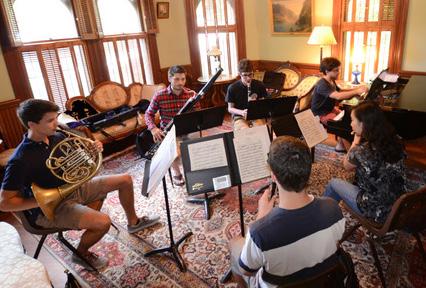
To sum up those two what and why questions posed by visitors to Festival Hill, JAMES DICK , the Institute’s founder is known to say, “Why dream the ordinary?”
James Dick received two Fulbright Fellowships for study at the Royal Academy of Music in London. He was named a Chevalier des Arts et Lettres by the French Ministry of Culture. In 2009, he received the Texas Medal of Arts for his work in the area of Arts Education. In 2022, he was recognized by the Texas State History Museum Foundation with the “History Making Texan Award,” recognizing living Texas legends whose contributions to the State have been truly historic and exceptional in scope.
An international concert pianist and a graduate of University of Texas, James Dick established Round Top Festival Institute in 1971. For 50 years, Mr. Dick has nurtured this dream for a unique, aesthetically pleasing, and acoustically superb venue for those who love music in its most ideal forms.


Since those early days in the ‘70s, when students performed in pastures and on porches, Festival Hill has grown slowly and methodically, piece by piece, and building by building. For many years, white plastic chairs and a makeshift stage were used for the concert hall, until a permanent stage could be completed. Mr. Dick recruited local farmers, craftsmen, and artisans to fulfill his dream of a facility as ornate as any of Europe’s great nineteenth-century concert halls.

Over the years, he patiently carved and built and taught and waited. He waited for that moment when his musical vision of students and audiences and pastoral beauty would become a reality. His strikingly beautiful Festival Hill Concert Hall was finally completed in 2007 and is decorated with red silk-upholstered seating for 1000 beneath hand-carved wooden ceiling panels. As one concert attendee put it, “Being at a concert at Festival Hill is like being in the middle of Europe.”




A hodgepodge of art and design is what makes Festival Hill Institute come together in a cohesive whole that can only be described as stunning harmony. Many of the buildings of Festival Hill Institute are a blend of old-world European, Victorian, and Czech-German influences. They provide student lodging, dining, plus rehearsal space for young artists, performers, and conductors. The campus is also used for conferences, meetings, and retreats, with guest housing for all those in attendance.
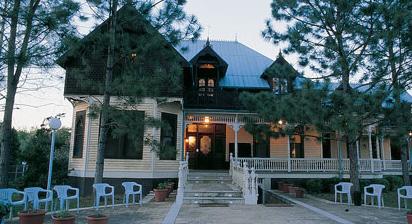 ABOVE: 1883 Edythe Bates Old Chapel, brought from La Grange and restored, serves as a popular wedding venue. BELOW: The Menke House, built in 1902, was moved from Hempstead and is used for meetings, parties,and small recitals, while the upstairs provides period-piece housing for guests and faculty.
James Dick performing at Festival Hill
ABOVE: Clayton House, a Victorian home relocated from La Grange, is used for faculty housing and starlit concerts on the porch. BELOW: Herzstein Memorial Plaza is used for large open-air gatherings, weddings, and reunions.
ABOVE: 1883 Edythe Bates Old Chapel, brought from La Grange and restored, serves as a popular wedding venue. BELOW: The Menke House, built in 1902, was moved from Hempstead and is used for meetings, parties,and small recitals, while the upstairs provides period-piece housing for guests and faculty.
James Dick performing at Festival Hill
ABOVE: Clayton House, a Victorian home relocated from La Grange, is used for faculty housing and starlit concerts on the porch. BELOW: Herzstein Memorial Plaza is used for large open-air gatherings, weddings, and reunions.
James Dick is living proof that a seeminglyimpossible dream can actually grow in the Texas countryside.
While Festival Hill Institute is known for its classical performances and ornate concert hall, guests are not only invited to come for the music but, also, to experience the tranquil beauty of nature.

The Institute’s campus is famed for its rare trees, fountains, picnic acres, lakes, and a series of gardens that are known throughout the country for their extraordinary collection of herbs. These herb gardens were created and built by Madalene Hill, famed pioneer of Texas herb gardening, along with her daughter Gwen Barclay.
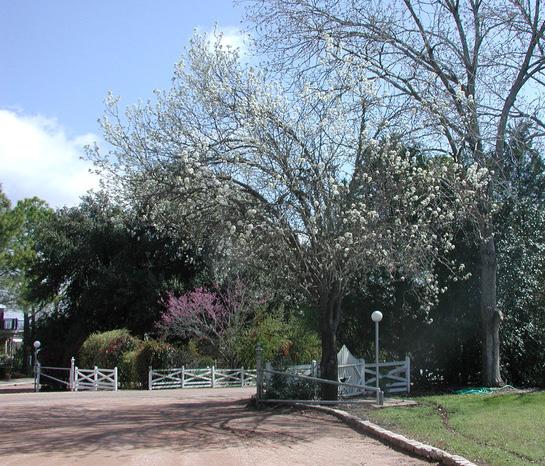
Meandering over five miles of hiking trails and strolling through the tree-covered grounds of the campus, visitors cross stone bridges and amble past rustic wooden benches set beside shallow ravines and stone sculptures.


Madalene Hill said of this place of music and nature that this is where one’s “whole psyche is nourished.”
Three hundred sixty-five days a year, visitors are welcome to come and feel the magic of this place. “The gates are never closed here,” promises James Dick.
References and Sources: For concert dates, location, and how to donate or fund scholarships, visit:
Round Top Festival Institute, An International Center for Performance and Learning • festivalhill.org
Southern Herb Growing, Madalene Hill, Gwen Barclay, Jean Hardy; Shearer Publications, 1987
If you love music— truly great music—come to Round Top Festival Hill, set amidst a symphony of sound and light where music and setting become one in the magical Emerald City of Texas.

Beekeeping is one of the oldest forms of agriculture in the world.
The ancient Greeks thought of bees as a symbol of immortality, and the world’s oldest honey dates back to the 35th century BC.
Beekeeping enterprises include production of beeswax, honey, edible bee products, crop pollination services, and the sale of bees to other beekeepers. The term beekeeper refers to a person who keeps honey bees in beehives, boxes, or other receptacles. However, a beekeeper does not control the creatures, as the bees are free to forage or leave as they desire. Bees usually return to the beekeeper’s hive, as the hive presents a clean, dark, sheltered home.
Fort Bend County has a large contingent of successful beekeepers, hobbyists, and bee removers, all with the common goal to produce the best raw local honey, to save the county’s bee population, and to further the protection of nature’s most efficient propagators.

Through membership in the Fort Bend Beekeepers Association, the Texas State Beekeepers Association, and other area like-minded associations, these bee afficionados share skills on how to raise bees, how to build and sustain apiaries, and how to collect honey. Through educational endeavors to foster and increase the bee population in the county, these associations provide an invaluable service.
With the keeping of the hive, beekeepers allow for that wonderful balance of keeping the bee hive active and the bees healthy. In turn, humans reap the benefits of crop propagation and honey production.
We are known as Fort Bend’s Award Winning Apiary, and we pride ourselves on representing excellence in Texas and on a National level.
Customers can find us at the Fulshear Farmers market every 2nd and 4th Saturday of the month from 9am to 1pm. If there is a 5th Saturday in the month, we are also typically there. You can also find us in the middle of the store at the Painted Tree boutique in Cinco Ranch and on a table at the Painted Tree in Sugar Land.
Our primary apiary currently consists of 25 acres in Needville that are full of fruit trees and wild flowers, with an average of about 50 bee hives on site. We intentionally use no pesticides, herbicides, or fungicides on our property to ensure the bees are never accidentally exposed to any harmful chemicals.

We always suggest to new beekeepers to get quality, gentle bees from a reputable breeder with good genetics. Our favorite supplier of bees and equipment—boxes, suits, smokers, and tools— is Mann Lake (Mannlakeltd. com). The company offers free shipping on most items, and that is a huge plus for cost savings!
Local bee clubs have extractor loaner programs so new beekeepers do not have to spend tremendous amounts
on equipment their first year. On the other hand, we do recommend that they purchase the best ventilated bee suits they can afford.
We want consumers to understand that 70% of honey bought in stores is not from local bee populations; it is imported. When you buy honey, you want to look for Raw, Unfiltered. Locally Grown, Texas Honey.

While I’ve been catching bees since I was a child, Brent and I have been raising bees together since 2015. We were the 2022 winners of the Black Jar Honey Contest, and we won Peoples’ Choice award for Best Tasting Honey in Texas. While we do bee removal, we are primarily honey producers and sell and ship many honey products and bee equipment through our store, SweetNes Honey Beetique in Needville. Our products can also be found at Painted Tree in Katy, and our honey is available in 25 HEB locations around Fort Bend.

We cater to beginner beekeepers with our classes, equipment, and advice for smart beekeeping practices. Beekeeping can be an expensive hobby, but we have a few tips for getting started.
Find a mentor, someone who can help you understand the life of beekeeping.
Join a bee club like Fort Bend Beekeepers Association.
If you are raising bees in a neighborhood, make sure to check with your neighbors for any severe allergies they might have to bee stings.
Because it is only strong, healthy colonies that produce a surplus of honey, successful beekeepers need to learn how to responsibly read their colonies of bees. They need to know when the hive is becoming overly crowded and when to add a new box to give the hive adequate room to grow.
While we have 40 hives at our home in Damon, we keep 400 hives on various properties around the county, including an apiary at Houston Southwest Airport near Sienna Plantation.
We encourage interested beekeepers to join the Fort Bend Beekeepers Association, which boasts over 100 members. Our meetings are held once a month, on every 2nd Tuesday at 7pm at the Fort Bend County Fairgrounds. These meetings are open to the public. If you wish to become a member, you can join for $20 and receive a handbook and a hat.
We encourage consumers not to be fooled by labels in the store that read “Pure Honey.” Honey is the #3 most adulterated food in the country. Real Texas Home is a non-profit organization that, with a silver seal of approval, helps guarantee that honey sold in stores is truly Texas honey.


We are fulltime beekeepers with over 300 hives located at several bee yards in the Brookshire/Fulshear and Simonton/Patterson areas. You can find our local honey, creamed honey, and infused honeys (Cinnamon, Lavender, and Lemon Ginger) at the Fulshear Farmers Market on the 1st and 3rd Saturdays of every month, and at the Katy Market Days in downtown Katy on the 3rd Saturday (Mar- Nov). Our products are also available at the Painted Tree Cinco Ranch location.

We are members of Fort Bend Beekeepers Association, Central Texas Beekeepers Association, and Texas Beekeepers Association.

We are passionate about the business of beekeeping, and this is why we offer beginner classes for new beekeepers. Our 4.5-hour Intro to Beekeeping class, consisting of roughly 10 students, covers bee anatomy, how to get started with bees, where to place hives, and what types of equipment are needed. Plus, we teach about pests, problems in the hives, and even don full suits with the students and hold live inspections of the hives.
Basically, our role as beekeepers is to facilitate hive growth and health of the bee colonies. For example, bee boxes are usually stacked one on top of the other, because bees like tall, narrow, chimney-like boxes, reminiscent of the inside of a tree. They like to go up, just as if they were inside a tree. As beekeepers, we want to replicate
Photo Courtesy of Hepplewhite Farms Photo Courtesy of Hepplewhite Farmswhat the bees like to do naturally. We like to explain to prospective beekeepers that we are facilitators to what the bees do. In other words, we help them to do what they are meant to do—forage, build combs, breed, and bring in nectar and pollen. Anything different from that can cause the bees to fail. If we help them become stronger and heathier, they make honey and more bees, and that is the objective.
New beekeepers will need basic equipment but, in the beginning, there is no need to buy an expensive extractor. You can take a knife and scrape the honey off the frames and put the honey through cheesecloth.
Because we understand the benefits of honey for allergies, all of our bee yards are located within 3-5 miles of our main yard. We collect honey in the spring, summer, and fall. To keep the consistency of the flavor of our honey the same throughout the year, we mix spring, summer, and fall honey together. This also provides a pollen source for every season in each jar of honey.
While it is apparent that all honey is not created equally, and the flowers visited by the bees determine the honey’s color and flavor, our local beekeepers and honey producers maintain a perfect balance of local pollen sources, meticulous honey collection, and excellent maintenance of healthy hives.
Responsible beekeeping allows honeybees to live as they would without human interference and maintains honeybee colonies in a way that promotes the health of the species. With this common goal, the beekeeper and the bee colony work together to build a life that benefits all.
So, the next time you see your local beekeeper at the farmer’s market or store selling pure Texas honey, say,
SOURCES:
Houston Bee Rescue LLC
houstonbeerescue@yahoo.com
(281) 627-7700
SweetNes Honey Beetique
8922 Main Street • Needville, Texas 77461
SweetNes Honey Apiaries
www.sweetneshoney.com
(832) 303-1595
Hepplewhite Farms
Brookshire, Texas
Hepplewhitefarms.com
(713) 416-9160
Beekeepers collect the honeycomb frames from the hives and scrape off the wax caps that the bees make to seal in each cell. The frames are then placed in an extractor-a centrifuge that spins the frames, forcing honey out of the comb, so that it can be collected for bottling.
Honey contains mostly sugar, as well as a mix of amino acids, vitamins, minerals, iron, zinc and antioxidants. Bee nectar can also be used to produce beeswax for making candles, furniture polish, soaps, and cosmetics.
When honey is crystalized, all of our beekeepers recommend you heat up a pan of water on the stove, then take it off the burner and put the jar of honey in the hot water. It is important to use slow heat, because water that is too hot will kill all the good enzymes that are so beneficial to human health.
 Photo Courtesy of Monica Siwiak
Photo Courtesy of Monica Siwiak
“Thank you for all you do!”

Our guest photographer, Raymond Choo, has been published in National Geographic. Please visit his website, raymondychoo.zenfolio.com to see more amazing photography. Want to enjoy looking through the sights and sounds of home from your very own living room? Raymond collaborated with three other residents of Cross Creek Ranch to produce a high-quality coffee table book entitled, “Fulshear & Beyond: Wildlife of Southeast Texas.” To learn more, visit texwildlife.square.site



 LEFT: Crested Caracaras • TOP LEFT: Meadowlark • TOP RIGHT: Wildflowers • BOTTOM LEFT: Sunrise & reflections, CCR • BOTTOM RIGHT: Damselfly
LEFT: Crested Caracaras • TOP LEFT: Meadowlark • TOP RIGHT: Wildflowers • BOTTOM LEFT: Sunrise & reflections, CCR • BOTTOM RIGHT: Damselfly

Many of us have seen the Hollywood Cowboys like John Wayne, Ronald Reagan, and Tex Ritter. The first use of the term “cowboy” was a description used as early as 1820 in Texas. But would you be surprised to know that the first use of the term “cowboy” was derogatory? If you called a white man “cowboy,” not only would you have insulted the man but would also have set yourself up for a fight. . . or even worse. White men were referred to as cowhands, cowmen, or cowpunchers. The first use of the term “cowboys” was for slaves. During this time period and up until the Civil War, the ranch had “house” boys, “yard” boys, and “cow” boys. Cowboys were responsible for finding and gathering the cattle that had gone into the woods and down by

the rivers to feed. While working on the George Ranch in Richmond, Texas, Mr. Callies found a printed article on the origins of cowboys. He has a copy in the museum for visitors to read. This catapulted his desire to reveal the Hollywood myth versus reality.
Larry comes from a long line of cowboys. His grandfather, father, uncle, and cousin are all wellknown black cowboys. In 1967, his cousin Tex Williams was the first black cowboy to compete and win in the Texas State High School Finals. His family has had a big impact on educating and furthering the reputation of Black Cowboys. He is also related to English royalty and the “Old 300” of Texas history.
Larry was placed on his first horse when he was only three. His father, Leon (Puggy) Callies, taught him how to ride and be a cowboy. When Larry was in fourth grade, his teacher asked his class what they wanted to be when they grew up. He loudly and proudly declared that he wanted to be a cowboy. The class laughed at him, but that did not deter him from his dream.
He began his cowboy career by competing in a rodeo when he was only 15 years old. He rode his first steer at the Simonton Rodeo. Not only was he the only competitor that didn’t get bucked off, he stayed on the entire eight seconds and won the championship. In 1971, Larry was the 2nd Black to make it in the Texas Youth Rodeo State Finals. Larry has competed in roping steers, bulls, calves, and as a team roper.

Besides being a cowboy, Mr. Callies was a well-known country singer. His career began in the 1980’s, but it took off after he placed in the top three at the Bear Creek Competition in 1984. He has opened for Selena, the Texas Tejano singer. He performed for George H.W. Bush and had the same manager as George Strait. He sang and played guitar with The Bronco Band, the band Clint Black acquired when Larry lost his voice. He released the songs, A Little Bit Of Charlie In Me and on the flip side If I Had A Cheating Heart. Unfortunately, he developed vocal dysphonia about two weeks before signing a contract with Erv Woolsey, George Strait’s manager. Mr. Callies went through extensive therapy, and he is now able to speak with a strained voice, but he no longer sings.
After his singing career ended, he hired on at George Ranch in Richmond, Texas. It is now a Historical Park, and Larry participated in the reenactments of life on this ranch that were held on the grounds. His first job was repairing saddles. Larry became so proficient at it that it led to him opening his own saddle repair business. He was also able to return to the rodeo circuit, competing in calf and team roping. He won many championships between 1998 and 2017.
When he was at the ranch in 2011, a young lady named Kimberly Agarwal took his picture. She explained that she wanted to paint the photo and enter it into the Houston Livestock Show and Rodeo Art competition. Larry was skeptical, since no picture of a black person had ever won. She persisted and won the Grand Prize in the art competition. It has since sold for $205,000.00 and
has sold 3000 prints at $300 each. He has a copy of the painting displayed in the museum and on the cover of his book, Here Comes Cowboy Larry, Stepping Out in Faith He has been written about in the Houston Chronicle, New York Times, on Houston television station KPRC, and featured on click2houston.com/BlackHistory.
In 2016, while working in a saddle shop, Larry felt the nudge to open a museum to honor the Black Cowboy. Because of his heritage and that article he found at George Ranch, he was encouraged to set out on this venture. He had gathered many artifacts from his rodeo, saddle repair, and musical experiences. Since these articles specifically highlighted the history of the Black Cowboy, he decided that it was time for him to do so, as well. His first museum was located at the intersection of Highways 90 and 36. The grand opening was a huge success and, like they say, “The rest is history.” The guitars from his musical days, riding gear, and saddles he has collected or worked on, are prominently displayed. These artifacts are surrounded by photos of his performances in the rodeo and on stage. A print of the painting that won Grand Champion in the Art Competition at the Houston Livestock Show and Rodeo is prominently displayed. In a special room are tack (horses bits and reins) and guns that are not only of historical significance but that are also collectors’ items. He owns and hangs up high a horse bit that is 1200 years old from Africa! Each piece, photo, and memorabilia encourages the visitor to delve deeper into this topic of history that is not very well known. Time stands still as the visitors absorb all the history that is around them.
Make sure you have unrestricted time to visit the Black Cowboy Museum, because every turn of your head reveals something new. Most days, you will find Larry at the museum. His stories are delightful and make this place come alive. You will experience his compassion, his creativity, and his conception, with each and every item and story.
SOURCES: Interview with Larry Callies
Here Comes Cowboy Larry, “Stepping Out in Faith,” by Larry Callies with Michael D. Buford
Black Cowboys Out West






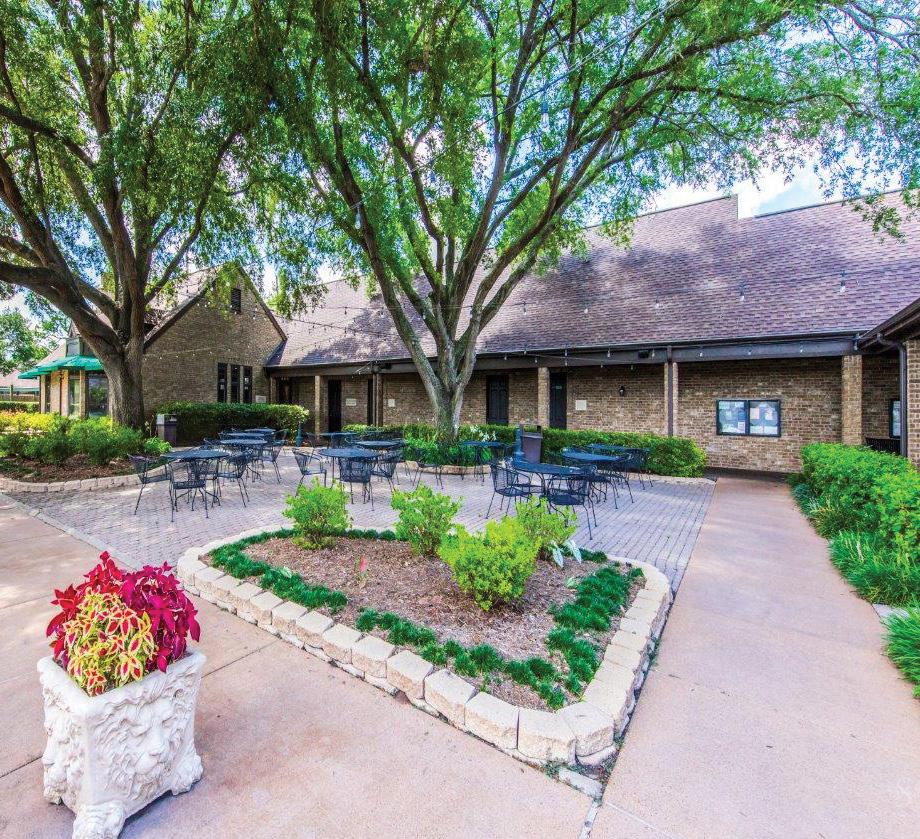

DISCOVER PLACES TO LIVE, WORK, AND PLAY
EXCLUSIVE LUXURY PROPERTIES


AMERICA’S FARMS AND RANCHES
ENGAGING & IMPACTFUL TARGETING OF YOUR MESSAGE

 GUARDIAN ANGEL CATHOLIC CHURCH
GUARDIAN ANGEL CATHOLIC CHURCH
Ihave often asked myself, “If that building could talk, what would it want me to know?” Would it talk about its history? Would it tell us the stories of the people who have come and gone within its walls? Would it be willing to share the stories that give the church its personality?
Fortunately, within a few hours of the Katy/Fulshear area, there are buildings that can talk. They talk through their architecture, their history, and the people within their walls. These are known as the Painted Churches of Texas. These churches were erected by Czech, Polish, and German settlers who wanted a taste of home in their new land. While there are more than 20 painted churches still open today, many of these architectural works of art are in the Schulenburg area, but there is also one in nearby Wallis.
The nearest Painted Church to our area is Guardian Angel Catholic Church in Wallis, about twenty minutes from downtown Fulshear. This is an active church that still holds Mass and is listed on the National Register of Historic Places. The church has reopened for tours.

On the north side of the parking lot is The Grotto. Guarded by an angel at the apex of this small outdoor stone structure is an altar to offer prayers and light candles. Across the street is a half-circle of wooden crosses. Each cross represents a remembrance of the Stations of the Cross. These are traditional in Catholic churches and mark the journey Jesus Christ took on the day of his crucifixion. Inside the nave, where parishioners sit, these crosses are situated under a huge oak tree with benches for activities, such as contemplating, resting, and praying.
On the east side of the church are two statues in a prayer garden. One is a life-sized statue of Jesus, seated at an unoccupied table representing the Last Supper. There are twelve empty stools around the table for visitors to join in the scene. The second bronze statue is of Saint Teresa of Calcutta. She, too, has space on the bench to sit, rest, and contemplate her message of love and compassion.
The modest, wood frame, Gothic Revival structure has a surprise inside. This church is filled with life-sized statues and stained-glass windows. This was one of the last painted churches to be constructed in Texas. The stained-glass windows were created in Italy and have their donors memorialized in the Czech language. In the bell tower are three brass bells that are still in use today. The original was destroyed by a devastating storm in 1900. The present building’s construction began in 1913 and was completed in 1915. This beautiful church was designed by San Antonio architect, Leo Dielman, and
was built by Jan Bujnoch of Wallis, who had the help of the Czech parishioners. The red and white interior is newly painted. The altars were kept as close to the original style as possible. This area is to be the focus of attention of the church. The paint is a white and gold theme. The red carpet leading to the altar and the red archway above it further draw a parishioner’s center of attention toward the front of the church. Another statue of Jesus looks over the interior of the church from the rear balcony.

of the mid 1800s called this town Mulberry. Since Mulberry was later a hideout for a local bandit group called the Hottentots, the town was often referred to by that name. As well as the painted church in Wallis, St. Mary’s also offers grottos to light candles for the military and for parishioners who have passed.
A second larger church was built on the same site forty years later in 1876. St. Mary’s Church of the Assumption, also known as St. Mary’s, is one of four painted churches in Fayette County. The present stone church was completed in 1895. The interior was painted al fresco, which means fresh air and is an artistic method by which the artist paints on wet lime plaster. The artist was Gottfried Flurry, (sometimes spelled Flury), a native of Switzerland who resided in nearby Moulton, Texas. He used stenciling, infill painting, and freehand techniques. He also employed the use of trompe-l’oeil, which is an artistic method to “trick the eye.” Using feathers, he painted columns to look like marble. Managing to avoid damage from natural disasters throughout the years, St, Mary’s is the oldest of the painted churches.
Figurines of the apostles can be seen replicated on the doors inside and outside the church building. Oil paintings with light blue backgrounds are hung low for each visitor to stop, pray, and take in the meaning of each representation of the Stations of the Cross. The matching robin’s-egg blue ceiling is the original color, created from a secret formula that included buttermilk. The church houses an elaborate confessional and a replica of The Pieta –a statue (translated as “the pity”) of a sorrowful Virgin Mother holding the body of her crucified son. The original Pieta by Michelangelo is on display in Saint Peter’s Basilica in Rome, Italy.

Nicknamed St. Marys’ Church of the Assumption and located in the current town of Praha, this solid rock church is located south of Interstate 10 and three miles east of Flatonia. Praha is the Czech way of spelling and pronouncing Prague, the capital of their Czechoslovakian home country, now known as the Czech Republic. The community is often referred to as “Maticka Praha,” which is Czech for “Mother Prague.” The town is also known as the Czech capital of Texas.
Praha is listed in Lindsay Baker’s book, Ghost Towns of Texas. Located in Fayette County and listed on the National Register of Historic Places, the first Anglo settlers
 Photos Courtesy of St. Mary’s Church of the Assumption
Photos Courtesy of St. Mary’s Church of the Assumption
“The Queen of Painted Churches” is located north of Schulenburg on Interstate 10. Also known as Nativity of the Blessed Virgin Mary-High Hill, to distinguish it from the painted church in Praha. It is considered the most beautiful of the painted churches. The designer of Guardian Angel Catholic Church in Wallis was also the creator of this Gothic Revival style church. Unlike the others, this church has German origins. The town was a combination of three settlements and was named as a reminder of the mountains they left behind in Germany and Austria. The first St. Mary’s was built in 1869. A larger church was built in 1876, and the original became the school, which is commemorated in the parking lot with a historical marker.

In the vestibule is a wall decoration written in golden letters. “Ich werden eingehen in Gottes Altar, will dich loben mein Gott,” which translates from German into English, as “I will enter into the altar of God and will praise you my God.” The entrance to the sanctuary, guarded by golden crosses on lattice wooden swinging doors, is an invitation to the grand architecture within.
Parishioner Willy Schmidt - born in High Hill, then schooled, baptized, and married in this church, happened to be in the building readying for Sunday Mass. I asked him if he would turn on the lights, and he obliged. The lights reflected the golden arches and bounced off the faux facades. With the addition of light coming through the stained-glass windows to the side of the main altar, the reputation of this holy place was reaffirmed. Statues and artifacts radiated with golden color. The blue and white interior was originally painted by Ferdinand Stockert and Hermann Kern in 1912. They painted the designs freehand on canvases and then hung them like wallpaper. It is truly the Queen of the painted churches.
The people of the parish donated the stained-glass windows dated 1899, the year they were installed in the second church. When the present-day church was built, these beautiful windows were moved to the new building. It was built in 1906 and painted in 1912. One of the windows was donated by Anton and Anna

 Photo by Robin Ferguson
Photo Courtesy of St. Mary Catholic Church
Photo by Robin Ferguson
Photo Courtesy of St. Mary Catholic Church
Schmidt, great-grandparents of Willy Schmidt. When the finished stained-glass window arrived, honoring the Schmidt family, the last name was misspelled as Schmitt. Anton decided not to make a big deal of it and left the misspelling.
St. Mary’s at High Hill also has a replica Pieta, more colorful and detailed than the one in Praha. Behind this statue are stained glass windows which include Latin phrases. The interior Stations of the Cross are wooden with gold accents. A unique wooden structure that resembles a crown sits above the pulpit. There are rose windows on the side walls and the painted Lamb of God on the ceiling.
The list is long of the churches still to visit. When you visit listen to what they have to tell. Explore the country roads and miles of farm and ranch land. Leave the stress, worries of home behind, and enjoy the many aweinspiring painted churches of Texas and the surprises they have in store for you.
SOURCES: Special thanks to Willy Schmidt. He was instrumental in the information on the “Queen of the Painted Churches.”
FOR MORE INFORMATION:
The following will provide contact information for the churches mentioned in this article.
GUARDIAN ANGEL CATHOLIC CHURCH, WALLIS, TEXAS Guardianangelwallis.org
To arrange a tour, call the Parish office at 979-478-6532, Monday-Friday, from 9:00 AM to 1:00 PM.
ASSUMPTION OF THE BLESSED VIRGIN MARY, PRAHA, TEXAS stmaryspraha.org
Parish office: 361-596-4674
NATIVITY OF THE BLESSED VIRGIN MARY-HIGH HILL stmary-highhill.com
Parish office: 979-743-3117
The Diocese of Victoria granted photos of the Painted Churches in Praha and High Hill Texas, JJones@victoriadiocese.org.

GENERAL INFORMATION ON THE PAINTED CHURCHES OF TEXAS: Greater Schulenburg Chamber of Commerce Schulenburgchamber.org





Recipes, a compilation of ingredients and steps, lovingly get passed down from generation to generation. However, in some families, they pass down more than just a recipe. They pass down a living, breathing ingredient – their sourdough starters!
According to BBC goodfood, a sourdough starter is, “a culture of yeasts and beneficial bacteria which naturally occur and are allowed to ferment over the course of approximately five days. A portion of the starter, known as the levain, is mixed with bread flour to make sourdough.” The result? A delicious, chewy bread with a mild tang.
Sourdough starters are often referred to as mother dough, thanks in part to its popularity all around the world, but also due to its longevity. Its almost
6,000-year-old history traces itself to the Romans and the ancient Egyptians. The global pandemic brought this ancient form of baking back and inspired both seasoned and beginner bakers.
My husband and I are new to the world of sourdough, but our bellies have never been happier. And when it comes to sourdough, bread is only the beginning. Little Spoon Farm, a blog that highlights sourdough recipes, opened our eyes to the many possibilities of this magical starter. Muffins, cookies, brownies, and more!
These cinnamon rolls are a real treat! The sourdough replaces the yeast, enhancing the depth of flavor and texture. Your friends and family will taste the difference, guaranteed.
 WRITTEN & PHOTOGRAPHED BY JACLYN
WRITTEN & PHOTOGRAPHED BY JACLYN
Recipe from Little Spoon Farm
PREP TIME: 20 minutes | COOK TIME: 35 minutes
FERMENTING TIME: 10 hours | Servings: 12 rolls
EQUIPMENT
• 12” Cast Iron Skillet
• Mixing Bowls
• Bench-Scraper
• Cheese Grater
• Pastry Brush
INGREDIENTS
• 8 tablespoons (113 g) butter (cold)
• 2 ½ cups (300 g) all-purpose flour
• 1/3 cup (100 g) sourdough starter
• 1 cup (240 g) buttermilk
• 1 tablespoon + 1 teaspoon (25 g) honey (or granulated sugar)
• ¾ teaspoon (4 g) fine sea salt
• 1 teaspoon baking powder (hold back in initial mix)
• ½ teaspoon baking soda (hold back in initial mix)

CINNAMON-SUGAR FILLING
• ¾ cup (150 g) light brown sugar
• 2 teaspoons ground cinnamon
• 4 tablespoons (56 g) butter (melted)
CINNAMON ROLL GLAZE

• 1 cup (120 g) powdered sugar
• 1 tablespoon (14 g) butter (melted)
• 1 teaspoon (5 g) vanilla extract
• 2 tablespoons (30 g) milk
THE NIGHT BEFORE
1. MIX THE DOUGH: Use a cheese grater to grate the cold butter into a mixing bowl. Add the flour and use a bench scraper or pastry cutter to cut the butter into the flour. Add the sourdough starter discard, buttermilk, honey, and salt. Mix with a spatula until the ingredients are well incorporated. Cover the bowl and let rest on the counter for 10-12 hours. (DO NOT add the baking soda or baking powder. This will be added right before rolling out the dough)
1. MAKE CINNAMON SUGAR FILLING AND GLAZE: Mix the brown sugar and cinnamon in a small bowl, set aside. In a separate bowl, mix the glaze ingredients and set aside. Preheat oven to 375°F (190°C) and butter a 12” cast iron skillet.
2. ADD LEAVENING AGENTS: Mix the baking powder and baking soda in a small bowl with a fork until there are no visible lumps. Sprinkle the mixture on top of the dough and mix it in with your hands.
3. ROLL OUT THE DOUGH: Generously flour your work surface and turn the dough onto it. Flour the top of the dough. Use a rolling pin to roll the dough into a 12” x 22” rectangle.




4. CUT OUT ROLLS: Use a pastry brush to coat the top of the dough with melted butter and sprinkle the cinnamon-sugar mixture evenly over the surface, leaving a half inch bare along the edges. Starting on one side, roll the dough into a log shape. Use the bench-scraper to cut the log into 12 pieces (approximately 1.5 inches). Arrange the portions in the cast iron skillet, leaving space in between each piece to expand.
5. BAKE: Bake the cinnamon rolls for 35-40 minutes or until the tops are golden brown. Remove from the oven and glaze while hot.
Buzz into our Hive for a memorable, one-of-a-kind shopping experience. Enjoy chic apparel & accessories, unexpected gifts and statement pieces for the home all from different curators, designers and artisans, including four from our very own area!


Gretchen Gilliam (Co-Owner) / Glamour Gypsies / Fulshear Resident
Dulce A. David (Co-Owner) / My Sweet Cannella / Richmond Resident
Heidi Hanson / Heidi Houston / Katy Resident
Melissa Rubio / Bellitude / Katy Resident
ARA’S BARBERSHOP
(346) 667-9545
11525 S FRY RD STE 105 • FULSHEAR
WWW.ARASBARBERSHOP.COM

CHRISTIAN BROTHERS AUTOMOTIVE
(832) 648-1443
6150 FM 1463 • KATY CBAC.COM

DOZIER’S BBQ
(281) 346-1411
8222 FARM TO MARKET 359 • FULSHEAR
DOZIERSBBQ.COM



ESSENCE HOUSE CAFE
(281) 533-0255
8506 FARM TO MARKET 359 • FULSHEAR
ESSENCEHOUSECAFE.COM
EM’S PHO
(281) 346-8250
6420 FM 1463 #800 • KATY
EMSPHO.KWICKMENU.COM
FULSHEAR ACE HARDWARE


(281) 533-8571
8411 FM 359 • FULSHEAR
WWW.ACEHARDWARE.COM
HAPPY TRACKS TRAVEL
(832) 507-2030
FULSHEAR, TX
WWW.HAPPYTRACKSTRAVEL.COM
HUMBLE GROUNDS COFFEEHOUSE
(346) 387-6199
11525 S FRY RD #110 • FULSHEAR
HUMBLEGROUNDSCOFFEE.COM

LOCAL TABLE
(832) 437-5317
11525 S FRY RD SUITE 101 • FULSHEAR
EATATLOCALTABLE.COM
MOLINA’S CANTINA
(832) 789-6450
6300 FM 1463 SUITE 500 • FULSHEAR
MOLINASCANTINA.COM
ORLEANS SEAFOOD KITCHEN

6230
(346) 688-5600
FM 1463 SUITE 550 • FULSHEAR

ORLEANSSEAFOODKITCHEN.COM


PIER 36 SEAFOOD & OYSTER BAR
(281) 346-8379
8502 FARM TO MARKET 359 • FULSHEAR
PIER36SEAFOOD.COM

SANDEFUR CPA
(281) 533-0911
30502 2ND STREET • FULSHEAR
WWW.SANDEFURCPA.COM

VICTOR’S MEXICAN GRILLE
(281) 533-0040
8525 FARM TO MARKET 359 • FULSHEAR
WWW.VICTORSMEXICANRESTAURANT.COM



